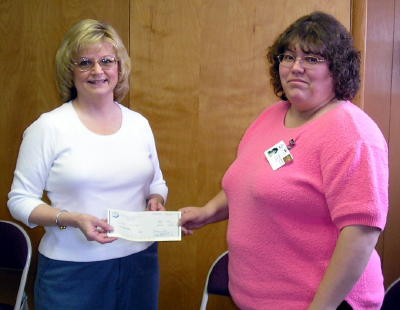HEAD LICE KITS DONATED - FRN Receives Check From MHHCC

FRN Coordinator accepts donation
from Minnie Hamilton Health Care Center
According to HeadLice.Org, nits (the eggs of the head louse) are small yellowish-white, oval-shaped eggs that are "to the side of a hair shaft glued" at an angle. Nits must be laid by live lice. You cannot "catch nits." Once laid, it takes 7-10 days for a nit to hatch, and another 7-10 days for the female to mature and begin laying her own eggs. Head lice are clear in color when hatched, then quickly develop a reddish-brown color after feeding. Head lice are about the size of sesame seeds. Head lice have six legs equipped with claws to grasp the hair. Head lice are crawling insects. They cannot hop, jump or fly. Head lice do not thrive on pets. Head lice are small, wingless insects which feed on human blood. They need human blood to survive. Head lice live for approximately 30 days on a host and a female louse may lay up to 100 nits (eggs). The National Pediculosis Association (NPA) suggests that most louse will not survive for more than 24 hours off it's human host.
There are several packaged treatment options available. The NPA suggests that you always look for any disclaimer that may be posted on the product. If you ask questions, ask a pharmacist or physician for their recommendation. Try to avoid closely repeated chemical treatments because this could damage the scalp or possibly cause your child to be ill. Lastly, the NPA states that effective screening and combing is the ultimate complement to whatever course of action an individual selects.
Any child can be infected with head lice. We encourage parents to take the time to check your child's head every day. Prevention is the key. MHHCC would like to encourage others who may be in the position to do so to donate funds or head lice kits to the Family Resource Network to guarantee our children are well taken care of. These kits will be equally distributed among the county schools. To make a donation or for more information, please contact FRN Coordinator Sandy Osborne at 354-7177.